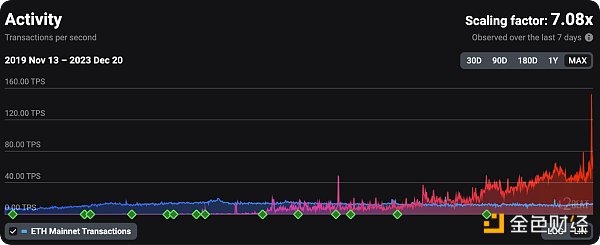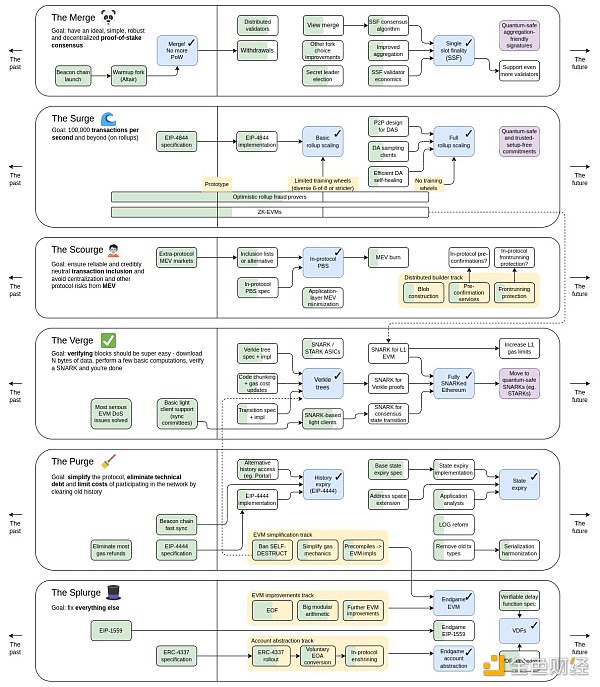Author: Bankless guest author Viktor Bunin; Compiler: Sharon, BlockBeats
Editor's note: The general rise of Bitcoin inscriptions and Solana tokens has not yet receded. At the same time, the performance of Ethereum and its ecology is not satisfactory. In an article published by Bankless on December 22, Bankless guest author Viktor Bunin discussed and predicted the future of Ethereum and L2.
He believes that on the one hand, the number of users of the Ethereum blockchain will decrease, and the relationship between Ethereum, the Ethereum ecosystem, and end users may become like Like a nesting doll, the Ethereum ecosystem no longer has a single overall narrative; on the other hand, the entire Rollup ecosystem will maintain the most important social principles of Ethereum - decentralization, trusted neutrality, and permissionless access and innovation. , and at the same time, the Ethereum blockchain will become a solid foundation that is established and taken for granted and supported. BlockBeats compiled the original text as follows:
There has been a lot of excitement on Twitter in the Bitcoin and Solana communities recently, driven by fundamental improvements and increased fees. , driven by the hype brought about by the rise in numbers related to tokens and so on. But the Ethereum community, the center of cryptocurrency adoption and innovation, can sometimes appear calmer. This makes me wonder, is it just that the numbers (on Ethereum) are not rising?
I think there is a deeper reason: the Ethereum blockchain is transitioning from B2C (execution) to B2B (settlement). This is the known technical outcome of Ethereum’s endgame, but what does it mean for the Ethereum social layer and community? I haven't seen many articles on this, so I'll try to unravel the topic here.
In the long run, will the number of users of the Ethereum blockchain increase or decrease from today? I think it's a reduction. L2 already consumes up to 20% of Ethereum’s gas, and I expect this proportion to continue to rise in the coming years, even if advances like EIP-4844 and Full Danksharding significantly reduce the cost of Rollups settling into Ethereum. Fewer end users of the Ethereum blockchain means that relatively few people will become part of the Ethereum community.
 < /p>
< /p>
Instead, people's identities will become like matryoshka dolls, primarily related to the user-facing components they interact with, such as Base, Arbitrum One, or Polygon zkEVM Such a network. You can see this today on Twitter - the aforementioned L2 communities are growing rapidly, but they are primarily focused on their respective chains rather than Ethereum more broadly.
 < /p>
< /p>
This reality makes it more difficult for people, especially critics, to understand Ethereum because it is no longer a single chain and community, but a network of An ecosystem composed of chains and communities. Ironically, this has also made it difficult for people to understand the Cosmos community over the years.
 < /p>
< /p>
This change also means that, by definition, the Ethereum ecosystem no longer has a single overarching narrative. The diversity of communities and perspectives is a narrative in itself that is inconsistent with what we typically see in the cryptocurrency ecosystem (e.g., Ethereum transitioning to PoS, Solana launching Firedancer, Bitcoin usage transitioning to the Lightning Network).
What is certain is that the Ethereum blockchain itself implements a vision through core developers and EIPs, which is described in Vitalik's updated roadmap , but it’s just one of many narratives within the Ethereum narrative, including Optimistic Rollups, zk-Rollups, shared sequences, privacy rollups, data availability, identity, NFTs, use case specific rollups (e.g. games), and more.
 < /p>
< /p>
This trend of community proliferation will not only accelerate on Ethereum, but will happen on every general-purpose smart contract chain. After all, the cryptocurrency ecosystem is planning to attract 8 billion people. Because scale breaks intimacy, it's reasonable to assume that over time there won't be just one Ethereum community, or just one Solana community.
So, what should we do now? What does it mean for the Ethereum community to successfully complete this transition?
Here, I'm looking for three indicators.
First, Ethereum’s most important social principles are maintained throughout the Rollup ecosystem. These principles are decentralization, trusted neutrality, and permissionless access and innovation. It doesn’t matter to end users whether the Ethereum blockchain is trustworthy and neutral if they are censored or if their assets are seized by the aggregation ecosystem.
Secondly, from a user perspective, they should enjoy the same level of security using Rollup as when transacting on the Ethereum mainnet. Tactically, this means that Rollups should inherit the security of Ethereum, and even if Rollups' sequence generators are untrustworthy, they should not have the opportunity to steal user funds.
Finally, I think the most important thing for Ethereum is that the Rollup ecosystem should use ETH as its primary currency. Beyond the tactical considerations (Rollups need ETH to settle with Ethereum, users already own and like ETH, ETH already has excellent monetary properties, etc.), the underlying reason for cryptocurrencies is: to create the best form of money in the world .
The Ethereum community cannot forget this goal. It’s time to build a currency that is controlled by anyone but used by everyone. And we have a great chance of achieving that. That’s not to say that every Rollup has to execute these pillars perfectly. Some may require KYC thresholds, others may use their own tokens for gas, etc. But these indicators provide us with a sense of direction - whether the Rollup ecosystem is driving the abstract concept of "Ethereum".
So, what does this mean for the Ethereum community?
This means that over time, you will hear less about the Ethereum blockchain itself and more about to news about the subcommunities within it. The Ethereum blockchain will become the established, taken-for-granted and solid foundation that we will assume its existence and support through the trials and tribulations of cryptocurrency growth over the coming decades.
This dynamic will mirror that of web2, where while the initial focus was on the Internet, we are now focusing on online communities while taking the Internet itself for granted. In many ways, the endgame for the Ethereum community is that everyone is part of the Ethereum community while no one primarily identifies as a member of the Ethereum community.
Of course, the concept of L1 fading into the background is not new. Anatoly Yakovenko, the founder of Solana, has advocated for years for a greater focus on things built on top of blockchains, rather than on the blockchain itself.
 < /p>
< /p>
As Solana continues to grow and gain adoption, I will be curious to see how the Solana community evolves over time. Because its monolithic design may bring the community closer together, its community may spread differently than what we see on Ethereum today. Meanwhile, all eyes are on the Ethereum community as it undergoes a fascinating transition toward greater diversity.
 JinseFinance
JinseFinance
 JinseFinance
JinseFinance JinseFinance
JinseFinance JinseFinance
JinseFinance JinseFinance
JinseFinance JinseFinance
JinseFinance JinseFinance
JinseFinance JinseFinance
JinseFinance JinseFinance
JinseFinance JinseFinance
JinseFinance Ftftx
Ftftx